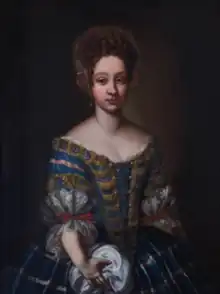Giovanna van den Eynde | |
|---|---|
| Princess of Sonnino and Galatro | |
 Giovanna van den Eynde, anonymous painting, Museum Correale | |
| Born | c. 1672 Naples |
| Died | 1716 Naples |
| Noble family | Van den Eynde |
| Spouse(s) | Giuliano Colonna, 1st Prince of Sonnino |
| Issue | Ferdinando Colonna, 2nd Prince of Sonnino, 3rd Marquess of Castelnuovo[1] Girolamo Colonna, Knight of Malta[1] Gennaro Colonna, Knight of Malta[2] Filippo Colonna[1] Cleria Virgina Lorenzo |
| Father | Ferdinand van den Eynde, 1st Marquess of Castelnuovo |
| Mother | Olimpia Piccolomini |

Princess Giovanna van den Eynde (also spelled Vandeneinden,[3] Vandeneynden,[4] Van den Eynden,[5] and Van den Einden[6]) (c. 1672 – 1716) was a member of the Van den Eynde family, Marchioness of Castelnuovo by birth, and the Princess consort of Galatro and Sonnino. She was the daughter of Ferdinand van den Eynde, 1st Marquess of Castelnuovo, son of the magnate Jan van den Eynde, and Olimpia Piccolomini, of the House of Piccolomini. Through her marriage to Giuliano Colonna, Giovanna became a member of the House of Colonna, and the first Princess of Sonnino. Through his marriage to her, Giovanna's husband acquired the title of Marquess of Castelnuovo.[7]
Family
She was born into the Van den Eynde family, a powerful and influential Neapolitan noble family of Flemish origin. Her father was Ferdinand van den Eynde, 1st Marquess of Castelnuovo, the son of Jan van den Eynde, a wealthy merchant from Antwerp who became one of the richest and most prominent men in Naples.[8][9] The Marquess Ferdinand married Olimpia Piccolomini, of the House of Piccolomini, a nephew of Cardinal Celio Piccolomini, by whom he had three daughters, Catherine, the eldest, Giovanna, the secondborn, and Elizabeth.[3][8]
Her grandfather Jan had acquired the monumental Palazzo Zevallos Stigliano in central Naples in 1653, sumptuously renovating it in the following years.[10][11] Jan van den Eynde was also the owner of the largest collection of paintings in Naples, which was bequeathed to his son upon his death. In 1674, the Marquess Ferdinand also inherited a sizable collection of 70[12] or 90[5] paintings from his longtime friend and business partner Gaspar Roomer.[8][13] However, Marquess Ferdinand died that same year,[5] and his collection, and assets, were split between his then-infant daughters, Giovanna and Elizabeth[8] (his eldest daughter, Catherine, was later judged incapacitated, according to some sources[14][3]). Van den Eynde's assets were frozen until each of his daughter reached adulthood and married.[14] Luca Giordano, another longtime friend of Van den Eynde, took care himself of the inventory for Van den Eynde's inheritance.[14] While drawing up the inventory, Giordano counted ten paintings executed by himself in Van den Eynde's collection.[14] Among the paintings inherited by Giovanna, there were six paintings by Giordano[14][8] and Mattia Preti's Belshazzar's Feast and The Banquet of Absalom.
Marriage
In February 1688,[14] she married Don Giuliano Colonna, of the House of Colonna, one of the most powerful families in Italy. Likewise, her sister Elizabeth married Don Carlo Carafa, of the House of Carafa, an equally powerful Italian family.[3][8] Through their marriage, she became part of the House of Colonna and the first Princess of Sonnino, while her husband benefited from a huge dowry,[15] and acquired the title of Marquess of Castelnuovo, as well as the opulent Palazzo Zevallos Stigliano.[8]
Progeny
She married Giuliano Colonna, 1st Prince of Sonnino.[8][3] They had the following progeny:
- Ferdinando Colonna, 2nd Prince of Sonnino, 3rd Marquess of Castelnuovo[1]
- Girolamo Colonna, Knight of Malta[1]
- Gennaro Colonna, Knight of Malta[2]
- Filippo Colonna[1]
- Cleria
- Virginia
- Lorenzo
References
- 1 2 3 4 5 6 "Libro d'Oro della Nobiltà Mediterranea". Comitato Scientifico Scientifico Editoriale del Libro d'Oro della Nobiltà Mediterranea. Retrieved 1 June 2020.
- 1 2 Corrispondenze diplomatiche veneziane da Napoli: 30 giugno 1739 - 24 agosto 1751. Istituto poligrafico e zecca dello Stato, Libreria dello Stato. 1994. pp. 852, 919.
- 1 2 3 4 5 Aldimari, Biagio (1691). Historia genealogica della famiglia Carafa pt 2. Stamperia di Giacomo Raillard. p. 314.
- ↑ Tzeutschler Lurie, Ann. Bernardo Cavallino of Naples, 1616-1656. Metropolitan Museum of Art. p. 245.
- 1 2 3 Bissell, Roger Ward (1999). Artemisia Gentileschi and the Authority of Art. Pennsylvania State University Press. p. 196.
- ↑ Pérez Sánchez, Alfonso E. (1999). Jusepe de Ribera 1591-1652. Metropolitan Museum of Art. pp. 77, 78, 288.
- ↑ "Nobili Napoletani". Nobili Napoletani.it. Retrieved 27 August 2020.
- 1 2 3 4 5 6 7 8 Ruotolo, Renato (1982). Mercanti-collezionisti fiamminghi a Napoli: Gaspare Roomer e i Vandeneynden. Massa Lubrense Napoli - Scarpati. pp. 5–55.
- ↑ Maria Grazia Lanzano. "6. Dai Coppola ai Lentini". Dizionario Dialettale di Gallicchio. Retrieved 1 June 2020.
- ↑ De Rose, Aurelio (2001). I palazzi di Napoli. Newton & Compton. ISBN 88-541-0122-2.
- ↑ Intesa San Paolo AA.VV. (2008). Gallerie di Palazzo Zevallos Stigliano. Intesa Sanpaolo.
- ↑ Berision, A. (1970). Napoli nobilissima. Charlottesville, Virginia: University of Virginia. pp. 161–164.
- ↑ G.Porzio, G.J. van der Sman (2018). 'La quadreria Vandeneynden' 'La collezione di un principe'. A. Denunzio. pp. 51–76.
- 1 2 3 4 5 6 De Dominici, Bernardo; Sricchia Santoro, Fiorella; Zezza, Andrea. Vite de' pittori- Dominici. Paparo Edizioni. pp. 772, 773.
- ↑ Bellori, Gian Pietro (1672). The Lives of the Artists (Bellori). Rome, Italy: Moscardi. p. 31.